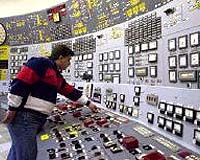 |
Tokyo (AFP) March 23, 2010 A company backed by Microsoft founder Bill Gates and Toshiba are in early talks to jointly develop a small nuclear reactor, the Japanese electronics giant said Tuesday. The Nikkei business daily earlier reported that the two sides would team up to develop a compact next-generation reactor that can operate for up to 100 years without refueling to provide emission-free energy. The daily said the joint development would focus on the Traveling-Wave Reactor (TWR), which consumes depleted uranium as fuel. Current light-water reactors require refueling every few years. "Toshiba has entered into preliminary talks with TerraPower," said Toshiba spokesman Keisuke Ohmori. "We are looking into the possibility of working together." Gates is the principal owner of TerraPower, an expert team based in the US state of Washington that is investigating ways to improve emission-free energy supplies using small nuclear reactors. Unlike the current reactors at mega power plants, the smaller types could be introduced by cities or states or in developing countries more easily. Ohmori said Gates, together with other TerraPower executives, had visited a Toshiba laboratory for nuclear power research near Tokyo last year. "TerraPower is developing a small nuclear reactor and Toshiba is developing a different kind of small reactor. They were interested in Toshiba's technology and aiming at practical realisation" of small reactors, he said. Ohmori said the two sides had just begun to "exchange information" but stressed that "nothing concrete has been decided on development or investment." Gates is expected to use his personal wealth to back the development of TWRs and his investment could reach several billion dollars, the Nikkei said. The news boosted Toshiba's share price by around four percent Tuesday. The Nikkei said TerraPower had decided to join hands with Toshiba as it lacks the know-how to manufacture nuclear power equipment. Toshiba, which owns US nuclear plant maker Westinghouse, has developed a design for an ultracompact reactor that can operate continuously for 30 years. The company is preparing to apply for US approval to start constructing the first such reactor as early as 2014 and put it into practical use by the end of the decade, Ohmori said.
Bulgarian reactor resumes operations after short circuit The reactor was restarted at 6:28 am (04H28 GMT) and was operating at 70-percent capacity by noon, the plant said in a statement. The other 1,000-megawatt reactor in Kozloduy continued operating at full capacity, it added. A short circuit in the turbogenerator's control and management system, which is in the radiation-free secondary circuit of the bloc, had caused the reactor's automatic shutdown on Sunday, without causing a radiation leak. Only two reactors remain in operation at Kozloduy, Bulgaria's sole nuclear power plant, after four outdated smaller units were closed in order for the country to join the EU in 2007. To make up for the lost capacity, Bulgaria plans to build a second 2,000-megawatt nuclear power plant at Belene, east of Kozloduy on the Danube, and possibly add new reactors at Kozloduy itself.
Share This Article With Planet Earth
Related Links Nuclear Power News - Nuclear Science, Nuclear Technology Powering The World in the 21st Century at Energy-Daily.com
 Short circuit shuts nuclear reactor at Bulgarian plant
Short circuit shuts nuclear reactor at Bulgarian plantSofia (AFP) March 22, 2010 A 1,000-megawatt reactor at Bulgaria's Kozloduy nuclear power plant was shut down late Sunday due to a short circuit but no radiation leak was detected, the plant said Monday. According to a press statement, the reactor was taken off the electricity grid at 11:03 pm (2103GMT) on Sunday following a short circuit in the turbogenerator's control and management system, which is in the radiation ... read more |
|
| The content herein, unless otherwise known to be public domain, are Copyright 1995-2010 - SpaceDaily. AFP and UPI Wire Stories are copyright Agence France-Presse and United Press International. ESA Portal Reports are copyright European Space Agency. All NASA sourced material is public domain. Additional copyrights may apply in whole or part to other bona fide parties. Advertising does not imply endorsement,agreement or approval of any opinions, statements or information provided by SpaceDaily on any Web page published or hosted by SpaceDaily. Privacy Statement |